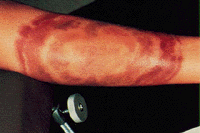
|
Clinical Features
The clinical manifestations of Lyme disease are variable from person to person. Parallels have been drawn between Lyme disease and syphilis because both are caused by spirochetes, both can involve multiple organ systems at different stages of the infection, and both can mimic other diseases. Common clinical manifestations and typical time courses of the different stages of Lyme disease are described in this monograph. More detailed reviews on the clinical manifestations of this complex disease are included in the references. Conceptually, it is useful to think of Lyme disease in three different stages (Table 1). Alternatively, one can consider stages 1 and 2 as early Lyme disease, and stage 3 as late Lyme disease. Although the clinical manifestations have been divided into stages, each person may have a unique presentation and progression of symptoms. |

Fig. 6 Erythema migrans. Courtesy of CDC. Click on the thumbnail for enlarged photo. |
|
Table 1 Major Manifestations of Lyme Disease* | |||
| System | Early | Late | |
| * | Stage
1 Localized |
Stage
2 Disseminated |
Stage
3 Chronic |
| Skin | Erythema migrans | Secondary annular lesions | Acrodermatitis chronica atrophicans (Europe) |
| Musculo- skeletal |
Myalgias | Migratory pain in joints, bone, muscle; brief arthritis attacks | Prolonged arthritis attacks, chronic arthritis |
| Neurologic | Headache | Meningitis, Bell's palsy, cranial neuritis, radiculoneuritis |
Encephalopathy, polyneuropathy, leukoencephalitis |
| Cardiac | * | Atrioventricular block, myopericarditis, pancarditis | * |
| Constitutional | Flu-like symptoms | Malaise, fatigue | Fatigue |
| Lymphatic | Regional lymphadenopathy | Regional/generalized lymphadenopathy | * |
| *This table was adapted with permission from: Steere AC. Lyme Disease. N Eng J Med 1989; 321:589 | |||